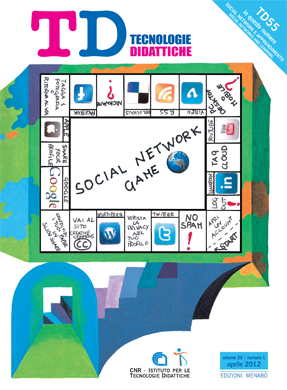Profili identitari e metafore per capire le potenzialità educative dei social network
Contenuto principale dell'articolo
Abstract
Dettagli dell'articolo
Sezione
Gli autori che pubblicano su questa rivista accettano le seguenti condizioni:
- Gli autori mantengono i diritti sulla loro opera e cedono alla rivista il diritto di prima pubblicazione dell'opera, contemporaneamente licenziata sotto una Licenza Creative Commons CC BY 4.0 Attribution 4.0 International License.
- Gli autori possono aderire ad altri accordi di licenza non esclusiva per la distribuzione della versione dell'opera pubblicata (es. depositarla in un archivio istituzionale o pubblicarla in una monografia), a patto di indicare che la prima pubblicazione è avvenuta su questa rivista.
- Gli autori possono diffondere la loro opera online (es. in repository istituzionali o nel loro sito web) prima e durante il processo di submission, poiché può portare a scambi produttivi e aumentare le citazioni dell'opera pubblicata (Vedi The effect of Open Access).
Riferimenti bibliografici
Bakhtin M.M. (1984). Problems of Dostoevsky’s Poetics (trans. C. Emerson). Minneapolis, MI: University of Minnesota Press.
Cambridge B., Kahn S., Tompkins D.P., Yancey K.B. (2001) (eds.). Electronic Portfolios: Emerging Practices in Student, Faculty, and Institutional Learning. Washington, DC: American Association for Higher Education.
Coffield F. (2000) (ed.). The Necessity of Informal Learning. Bristol, UK: Polity Press.
Cole M. (1996). Cultural Psychology: A Once and Future discipline. Cambridge, MA: Harvard University Press.
Cucchiara S., Sansone N., Ligorio M.B. (2012). AAAFuturo Cercasi: orientare con i Social Network. TD - Tecnologie Didattiche, 20 (1), pp. 40-43.
Gergen K., Davis K.E. (1985). The Social Construction of the Person. New York: Springer-Verlag.
Harré R., Van Langenhove L. (1991). Varieties of Positioning. Journal for the Theory of Social Behaviour, 21 (4), pp. 393-407.
Hermans H.J.M. (2003). The Construction and Reconstruction of a Dialogical Self. Journal of Constructivist Psychology, 16 (2), pp. 89-130.
Hevern V.W. (2004). Threaded Identity in Cyberspace: Weblogs and Positioning in the Dialogical Self. Identity: An International Journal of Theory and Research, 4 (4), pp. 321-335.
Joinson A.N. (2008). “Looking at”, “Looking up” or “Keeping up with” People? Motives and Uses of Facebook. In Proceeding of CHI 2008 (Firenze, Italia, 5-10 April 2008), http://people.bath.ac.uk/aj266/pubs_pdf/1149-joinson.pdf (ultima consultazione 09.12. 2011).
Krumm J., Davies N., Narayanaswami C. (2008). User- Generated Content. Pervasive Computing. IEEE, 7 (4), pp. 10-11.
Lakoff G., Johnson M. (1980). Metaphors We Live By. Chicago, IL: University of Chicago Press.
Lampe C., Ellison N., Steinfield C. (2008). Changes in Use and Perception of Facebook. In Proceedings of the ACM 2008 Conference on Computer Supported Cooperative Work (San Diego, CA, 8-12 November 2008). New York: ACM, pp. 721-730.
Lampe C., Wohn D.Y., Vitak J., Ellison N.B., Wash R. (2011). Student Use of Facebook for Organizing Collaborative Classroom Activities. International Journal of Computer- Supported Collaborative Learning, 6 (3), pp. 329-347.
Ligorio M.B. (2010). Dialogical Relationship between Identity and Learning. Culture & Psychology, 16 (1), pp. 93-107.
Ligorio M.B., Hermans H. (2005). Identità dialogiche nell’era digitale. Trento: Erickson.
Markus H., Nurius P. (1986). Possible Selves. American Psychologist, 41 (9), pp. 954-969.
Mazer J.P., Murphy R.E., Simonds C.J. (2007). I’ll See You On ‘‘Facebook’’: The Effects of Computer-Mediated Teacher Self-Disclosure on Student Motivation, Affective Learning, and Classroom Climate. Communication Education, 56 (1), pp. 1-17.
McGrath J.E., Tschan F. (2004). Temporal Matters in Social Psychology: Examining the Role of Time in the Lives of Groups and Individuals. Washington, DC: American Psychological Association.
Ortony A., Fainsilber L. (1989). The Role of Metaphors in Descriptions of Emotions. In Y. Wilks (ed.). Theoretical Issues in Natural Language Processing. Mahwah, NJ: Lawrence Erlbaum Associates, pp. 178-182.
Perret-Clermont A.-N. (ed.). (2006). Thinking Time. Seattle, WA: Hogrefe Publishers.
Sefton-Green J. (2003). Informal Learning: Substance or Style?. Teaching Education, 4 (1), pp. 37-51.
Turkle S. (1995). Life on the Screen: Identity in the Age of the Internet. New York: Simon & Schuster.
Vygotskij L.S. (1962). Thought and Language. Cambridge, MA: The MIT Press.
Wartofsky M.W. (1973). Models. Dordrecht: D. Reidel.

